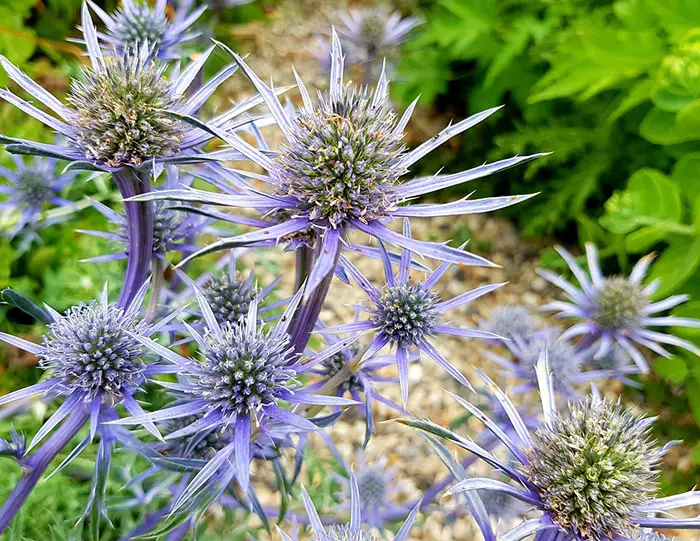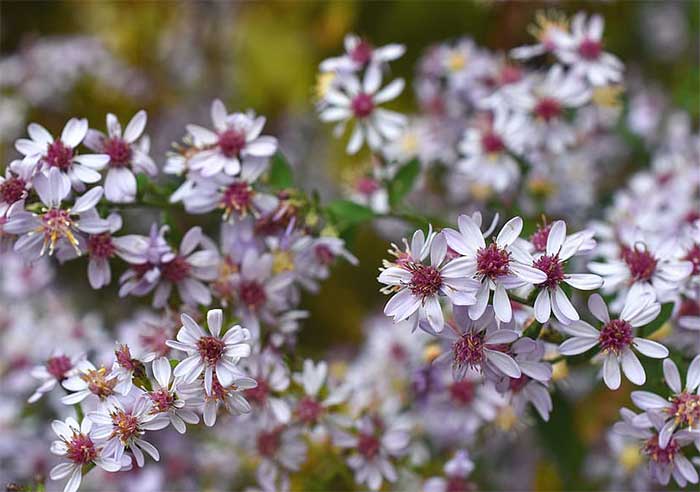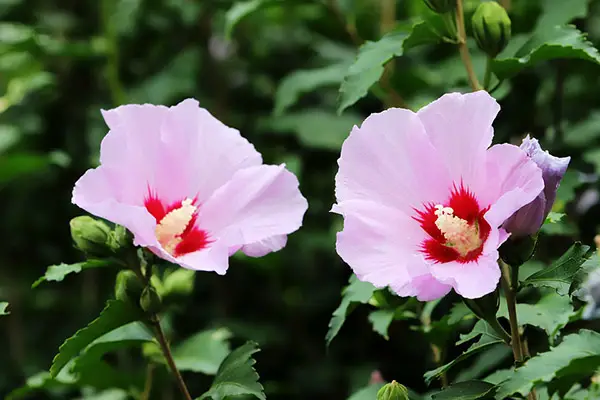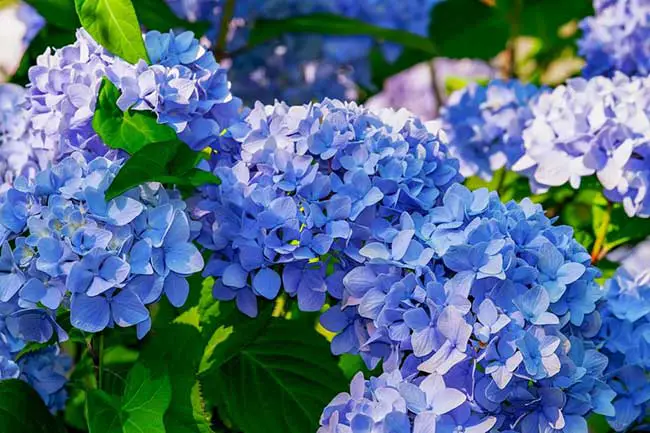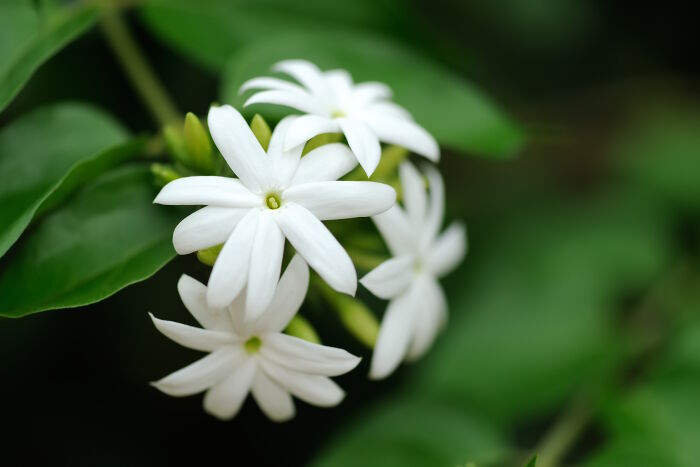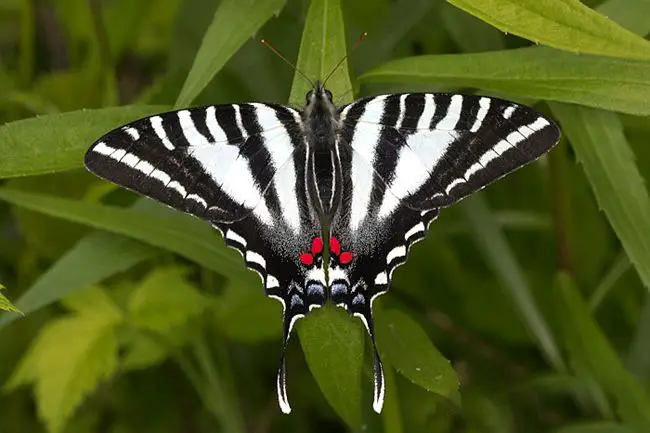Introduction of Ambrosia artemisiifolia
Ambrosia artemisiifolia is a common weed type plant species of the genus Ambrosia. It can easily find in the shrub area, agricultural, as well as garden areas. The plant is also known as Annual ragweed, Common Ragweed, Blackweed or low ragweed. This weed plant is native to the American region. However, now it has widespread in tropical and subtropical areas in the world. You can find this weed in almost all states in the United States and Canada. However, it has accidentally introduced to Europe in the middle 19th century. This plant is commonly considered an invasive species for crops. This plant species has the capacity to reduce the substantial amount of crops. However, in Europe, it is considered an extremely dangerous invasive alien species (IAS). Because it’s allergenic yellow pollen cause serious respiratory problems for humans, including rhinitis and asthma.
Ragweed plant distribution is controversial for many reasons. Because every summer, it tends to risk crop loss. Suppose the cultivation does not manage for 2 to 3 weeks after the initial plantation. Ragweed is the main competitor for spring-sown crops. In the United States, Common Ragweed is known for its summer allergen. Ambrosia substantially grows between May through June in most areas.
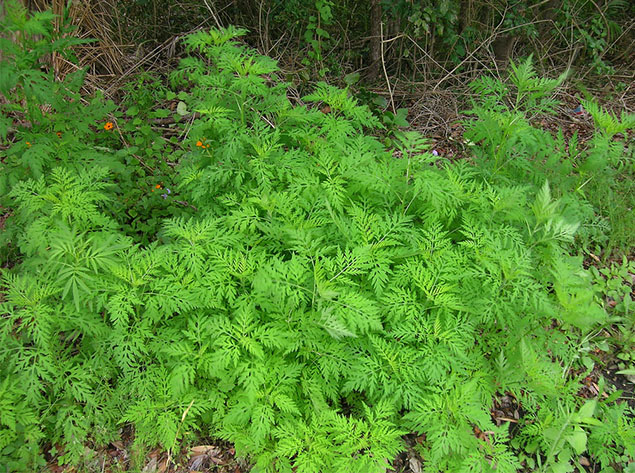
Basic Info
Seedlings
The seedlings have dark green, thick, and spatula-shaped cotyledons. The leaves are very hairy below, although it is hairy on top too. When the seedlings are getting older, these show more developed leaves. Ragweed Plant and especially seedlings are sensitive to freezing environmental conditions. Seedlings kill by the late spring frost, and the first autumn frost terminates the season of growing.
Leaves
There are two sections of the leaves that can be identified. When the leaves are twice as a compound, you can see the enormous difference between the lower leaves and the upper leaves. The lower leaves have longer petioles. Meanwhile, the upper leaves usually do not come with the petiole.
Mature plant
The mature plant of the Ambrosia artemisiifolia is obvious. They are bushy and noticeable. When the population density is low, it frequent branches and radiate around the plant. These can grow from three to six feet tall with alternate leaves and hairy stems. The stem is green to pinkish-red in colour. Mature leaves are generally hairless underneath. A single plant can produce 32,000 to 62,000 seeds during the entire growing season. The number of seeds produced is proportional to the biomass of the plant.
The mature plant of Common Ragweed can produce flowers. These flowers are tiny and green. But these flowers produce yellow pollen. These yellow pollens are the triggering factor of late-summer allergies in the eastern United States.
Flowers or Fruit
The same plant produces both genders of flowers in separate heads. The male flowers are located on the spikes at the top of the mature Common Ragweed plant. Meanwhile, the female flowers are placed on the joints between the upper canopy leaves and stems.
Honeybees are collecting honey from the male flower of Ragweed. However, other insects and larvae do not prefer the flower of both males and females.
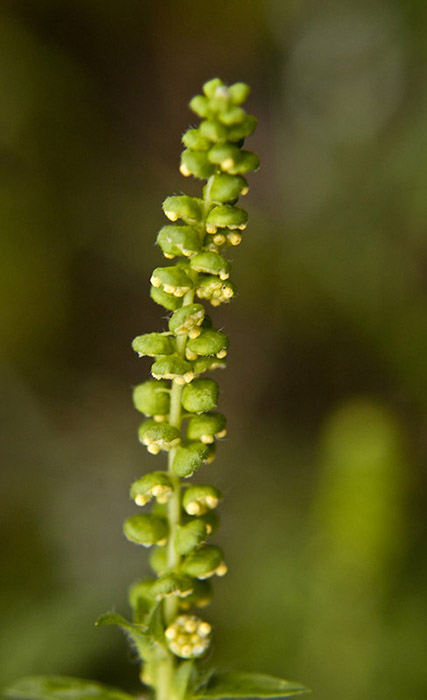
Growth of Ambrosia plant
Ambrosia grows in the average to dry conditions with the full sun exposure preference. The plant will grow in the soil with unique characteristics. The maximum cultivation can happen in the soil with high clay containment. Sand and gravel types of the medium are the best medium for optimum growth. It only grows in the sterile condition soil medium. Because there is lower competition from the other plants. Every single plant can live only within a season. A single plant of Ragweed can produce millions of allergens pollen within a single day. It can produce a total of over one billion pollen grains within its lifecycle.
While it can thrive in drier soil, the lower leaves could cease to flourish. The experts categorize this as the aggressive type. Because Ragweed’s seeds can stay and remain healthy in the types of soil for several years before degrading. Seeds need a prolonged cold temperature to break the dormancy.
The Common Ragweed plant is very common in the native habitat and the gardens. When the conditions are met, their growth becomes unstoppable. Basically, these plant habitats are cropland, abandoned fields, vacant lots, roadsides. Not only that, but also on vacant railroads, abandoned buildings, construction sites, waste areas, and pretty much anywhere.
Pollens are often released into the air in the morning to early afternoon. However, during the peak time of the flowering season, you will find everywhere over the space is full of pollens.
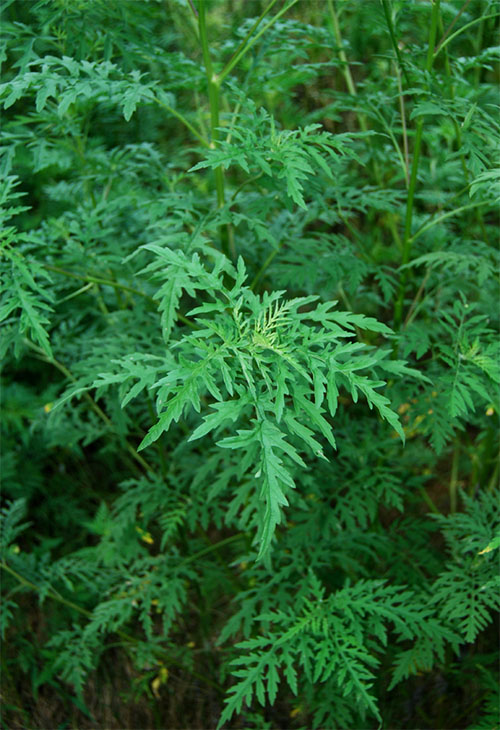
Ambrosia artemisiifolia Beneficial Uses
The common Ragweed plant is often useless because of the pollen, which can cause an allergic reaction. But also how it can rigorously grow in the garden. That is why many people call “weeds”. Regardless, these plants indeed have beneficial uses can consider.
Medicinal benefits of plant
Common Ragweed comes with both topical and internal applications, depending on its purposes. Ragweed is a common ingredient for herbal users and specialists.
Ragweed herbals are beneficial for relieving nausea, fever, and stomach discomfort. Ragweed also comes with the medicinal property, which can alleviate mucous membranes’ irritation with free mucous discharge.
Some people use the root of the ragweed plant to make the laxative tea. Meanwhile, the leaves of the plant can apply to the infected areas of the skin. It will soothe the irritation, itching, blemishes, and rashes. As the medicinal fever properties, the herbalists use the plant’s pollens to cure the hay fever.
The herbalists crush the leaves and rub the paste onto the affected area. It will not only soothe the symptoms but also deter any infection and after-effects. Many nature lovers use this plant as an alternative for medicinal properties.
Ambrosia plant has the potent astringent property. It can also be useful for handling health cases like dysentery or diarrhoea.
There is also a suggestion that the paste of the plant can prevent blood poisoning from the wounds.
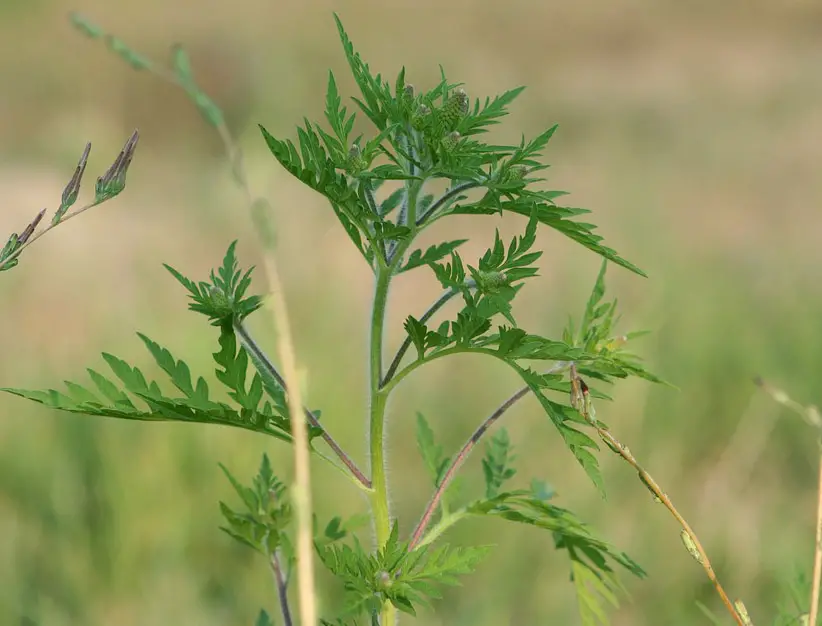
The Native Americans believed in Ambrosia artemisiifolia
Early native American people used ragweed as the traditional medicinal property. It may alleviate certain health problems. The Common Ragweed has been used as the antiseptic, astringent, emetic, emollient, and fever reducer in terms of therapeutic properties.
Cherokee, the indigenous people of the Southeastern Woodlands of the United States, use Common Ragweed for green corn medicine.
Common Ragweed indeed causes allergies which most people are bothered with. But these have such useful properties which have been passed down from one generation to another.
Ambrosia artemisiifolia’s best quality is its astringent property. Which is effective against hay fever. The common symptoms of hay fever are itching, a watery throat, runny nose, bloodshot eyes, and sore throat. However, you might not find the commercial products of the Ragweed plant. It is not for sale in over-the-counter stores in the US. Herbalists can confirm the effectiveness of the ingredient.
The experts also mentioned its effectiveness in handling gonorrhoea, one of the most irritating conditions for men. For centuries, the native people have also been using ragweed antiseptic for wounds, ulcers, and tumours.
Ragweed Medicinal uses according to older eclectic texts
This weed plant has been a controversial thing to discuss amongst the health community. At the same time, many homeowners see this as an allergen and weed. While the herbalists have different views of the clinical term’s ragweed uses.
Ambrosia artemisiifolia pollen can trigger allergic reactions. It shows the symptoms of watery eyes, runny nose, itchy throat, coughing, sneezing, and many more allergic reactions. And for those who have ever experienced allergic reactions by themselves, it might be hard to accept the Ragweed plant from the view of the medicinal property. It is undeniable that ragweed is often the culprit of such allergic reactions what people often show symptoms when exposed to its pollen. But what not many people know is that Common Ragweed is also the cure.
It will be hard to find modern research papers to promote Black weed as a medicinal property. But the older eclectic texts have shown a lot of proof that the Common Ragweed plant is the real ingredient that can be found with the mucous membranes. But it is more often used as a topical medicinal ingredient to alleviate infectious sores.
The Ambrosia plant’s use for the hay fever remedy uses goldenrod for the same symptoms. When applied correctly, the sufferers of hay fever can be benefiting from this plant. Besides being useful to alleviate the hay fever symptoms, the experts also commence the perks of Common Ragweed to overcome the allergic reactions to food, insects, and drugs.
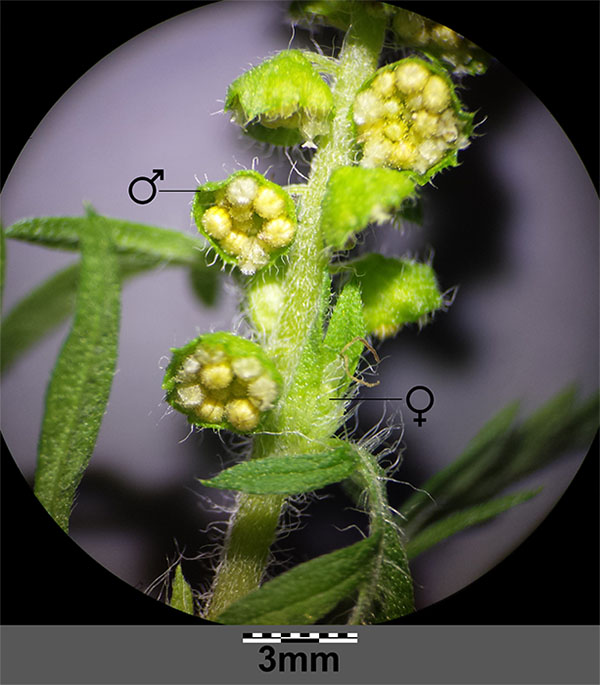
Manage Ambrosia artemisiifolia plant
The pollen of ragweed is light and airborne. When the wind blows, it can travel for miles away. To certain extents, the strong wind can make pollen travel as far as 500 miles. So, although your location is far away from the ragweed plant, there’s still the possibility to receive the pollen spread.
Like other types of weed management, you will want to use the herbicide to control the weeds. However, it is advisable to notice there’s a possibility for the second wave coming.
Single applications of herbicide might not be sufficient to control the weeds the entire season. Ambrosia artemisiifolia is famous for its competitive survival. To be successfully managing the Ragweed plants, you must use pre-emergent and post-emergent applications. There will be at least two times herbicide applications needed to manage it. Consider referring to the specific resources of the Common Ragweed management to know further information.
Biological controlling methods are using in widespread areas to reduce growth and distribution. Fungal rusts and the North American ragweed leaf beetle are the noticeable natural solutions so far.
How Gardener would handle the Ambrosia artemisiifolia
When autumn approaches, the plant will dominate if not being controlled. The pollen of Common Ragweed is airborne. Therefore, many people are often oblivious to the potential of allergic reactions. The ragweed plant starts to bloom in late July or early August. And from there, these can procure such allergic responses to many sufferers for months. Ambrosia artemisiifolia can grow anywhere in the US. So, no matter what you go, it will be easy to find the culprit of your allergic reactions.
All of the persons have such reactions in your body to ragweed pollen. That means your antibodies are working. The reactions will happen at the first sniff of pollen contaminated air. As the first sniff takes place, your body will start producing antibodies. That causes the histamines to stream in your blood. This is what makes such severe allergic reactions that people’s hate.
The offending plants avoid your garden if there are members who are sensitive to the pollen. It has been challenging to overcome the Ambrosia plant prevalence in the area of the property. When you abandon your property just for a while, the weed can quickly dominate the areas. These can happen to the borders, edges, and vacant space. The seeds of the ragweed can last for several years as dormant seeds. That’s why it has been challenging to counter its movement in the gardening or agricultural areas. However, seeds should be near the soil surface to germinate. Otherwise, they will remain as dormant seeds for a long time if not come up near the soil surface. Light and temperature combination play a major role in germinating the seeds. With global warming and climate change, Ragweed will prevail worldwide in the future.
Chemical control
For many gardeners, chemical control is considered to use commercial chemicals. However, we don’t like to recommend it to you. Commercial herbicides pose more threats to the environment than the Ragweed plant effect.
Some research has shown that Ragweed biotypes have developed resistance to herbicides over the past several years, making it very hard to eradicate from the field even by herbicides.
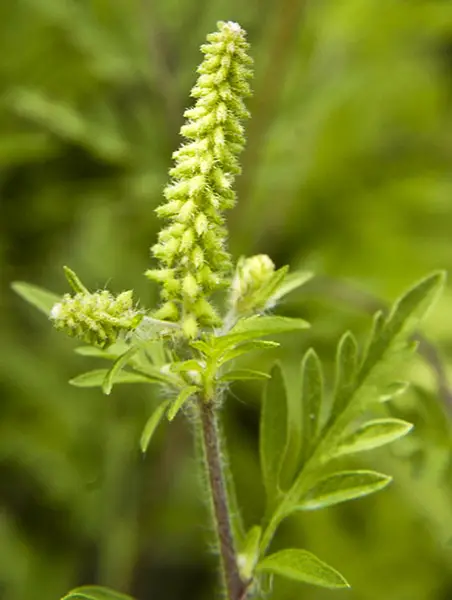
Physical control
Some people control the weed by cutting them to the ground. We suggest you not do it before you waste your time and energy. Cutting the whole plant to the ground is the same as pruning them. As you prune them on the ground, it will allow them to grow bigger next time. And when it does, you will realize that these ragweed has become bushy in the subsequent growth.
The gardeners must shower every after gardening activity to minimize the risks of getting allergic. The pollen might have entrapped in your clothes, tools, or other items. So make sure to clean up all the things before you come to your living room. The last thing you need to be aware of is that spreading the pollen to your house occupants. Launder all of the clothes, shoes, and gears to prevent the pollen’s soft and fluffy spread.
The lightweights of the pollen are indeed the determining factor of the spread. If you have pets in your home or garden, you need to be aware that the pollen can easily get caught by them, and your pets can bring it to your house. After walking your pets, or having an outdoor activity with your pet, use a damp towel to clean your pets. Or, you could launder your pets to clean them completely.
For more information, please read: Biology and Management of Common Ragweed
Dealing with the Ragweed allergic reactions
Research has shown that approximately 26% of the American people are allergic to Ragweed pollen. The primary chemical compound of the pollen, which causes the allergy, is two subunits of non-glycosylated protein. However, other allergenic components are also contained in pollens such as calcium-binding proteins and profilin.
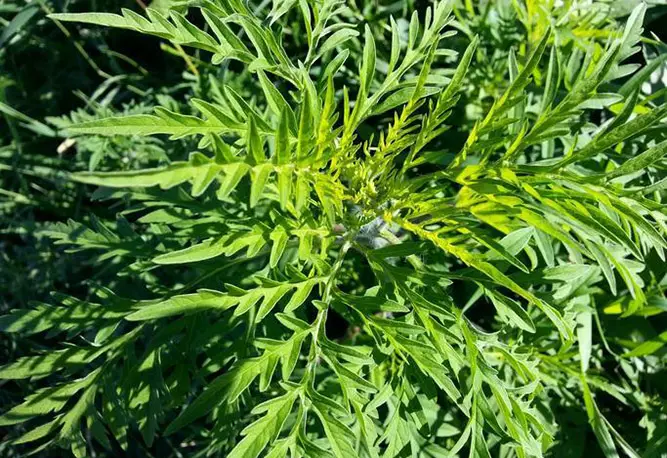
For those who have allergic reactions to the plants’ pollen, dethroning Ambrosia artemisiifolia from their property is the right choice. Basically, using over-the-counter allergy relief products can help you handle allergic reactions. Experts also recommend the family members who are prone to allergy take the homoeopathic a month before approaching the ragweed season.
Curing allergic reactions can be instant. But you need to know that the allergy season takes place from six to ten weeks. In most areas in the US, the peak of the season happens in mid-September. The symptoms might be visible until the first frost can kill the plant.
You can also find the best ingredients to alleviate allergic symptoms from your kitchen. If you can find peppers or mustards in your kitchen, you can take these in your meals. Peppers and mustards are the natural decongestants that can stimulate the mucus, blocking the nose to move out of the body.
Curcumin is another ingredient to take to inhibit the allergic response in no time. Curcumin can reduce intense symptoms such as runny nose, sneezing, and nasal congestion. You can easily find this spice in your favourite department store or traditional market. In some areas in the US, you can easily find curcumin in Asian stores.
Besides the ingredients above, you could also combine the diet with a variety of foods. Such as seeds, nuts, onions, berries, apples, tomatoes, etc. Focus on the food items that have anti-inflammatory, anti-oxidant, as well as anti-allergy properties.
FAQs
-
Can ambrosia artemisiifolia self pollinate ?
Yes. A single plant of Common ragweed can generate billions of pollen grains during their life cycle. Small and lightweight pollens spread several distances by wind around the origin plant.
-
What is ambrosia artemisiifolia used for ?
Traditional herbalists use Common Ragweed for the curing of Hay fever, Menstrual discomfort, Nausea and blood poisoning from old wounds. The sap of the Ragweed leaves extract can use to prevent the irritation of insect bites and ivy rash.
-
Is Ambrosia poisonous?
No. Generally, it is not considered a poisonous plant. However, its pollen causes serious respiratory problems in the human body when it enters the respiratory system. Therefore in Europe, it considers as an extremely dangerous invasive alien species.
-
How do you get rid of Ambrosia artemisiifolia?
-
Why is ragweed called Ambrosia?
-
Where did ambrosia come from?

